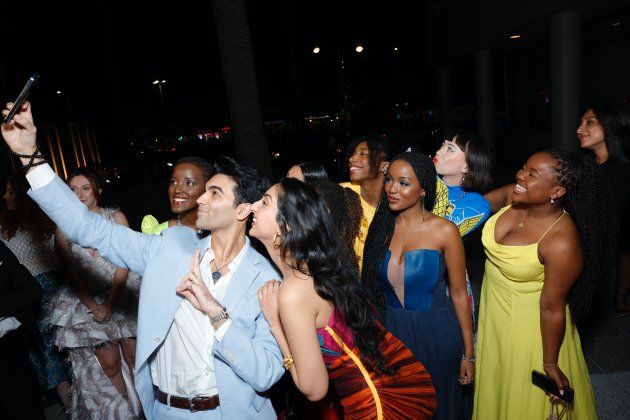From Megaphone to Microphone With Fashion, Climate Activist Saad Amer

Today’s young influential leaders are poised to make any platform a stage for activism and any moment Insta-worthy amid climate doom-ism. A sense of humor often helps.
“In many ways, when we’re talking about fashion, we’re also having a conversation about climate,” said Saad Amer, the climate activist and native New Yorker behind youth-centered voting advocacy organization Plus1Vote and eco-consultancy Justice Environment. “We have been taught to think of these things as separate. A climate activist versus a fashion activist. To me, what’s the difference? Probably just the outfit,” he said to the audience’s laughter.
More from WWD
Amer was speaking alongside Kerry Washington, Aurora James and more personalities aiming for change in fashion at a Kering and Marie Claire event last month. To the Harvard environmental sciences and public policy graduate — who also consults for the United Nations and serves as an expert reviewer for the U.N.’s Intergovernmental Panel on Climate Change — fashion is inseparable from climate.
“As we have these conversations about how they’re related, it’s the reality that the fashion industry is expected to grow by about 63 percent by 2030. Now for a company, that sounds great. However, for the global reality of the climate crisis, the IPCC tells us that we need to reduce our emissions in half in that same time frame. Now, you have a conversation, and now you have a need for the company to bring real solutions to the table so as to not compromise the reality of the climate movement.”
Global consumption of clothing and footwear is expected to increase from 62 million tonnes to 102 million tonnes in 2030, according to a 2019 report from the European Environment Agency. But, as with other activists, this reality is not one Amer is subscribing to.
“Young people, consumers, even more traditional luxury [shoppers] are looking to fashion companies and saying, ‘Hey, I want a better option. I want to dress well. I want to look cute, but I’m not trying to destroy the planet,’” he added.
His quippy one-liners resonate well with the always-online generation. From iPhone green carpet selfies, sleek microphone to a “V-O-T-E”-etched megaphone, Amer never loses his polish or values. Even while partaking in a March climate protest in New York City, Amer’s hair looked perfectly coiffed and his (vintage) tweed blazer fitted to a T. The march was organized by Greta Thunberg-founded Fridays for Future, alongside other local organizers.
“With each march, the movement moves closer to its goals. With each march, the science is heard louder. With each march, we come closer to climate justice,” Amer wrote on Instagram amid a carousel of spirited action shots.
But dialed down in a quiet setting, Amer reflected candidly, “I didn’t have to change who I am to be here,” over the phone one rainy late afternoon in the Hell’s Kitchen neighborhood of Midtown, close to where he grew up. “I’m here because of who I am and what I brought to the table.”
Résumé aside, who he’s brought to the table is of relevance too. Everyone from Jane Goodall, Bella Hadid, Al Gore, Alexandria Ocasio-Cortez and more has engaged with Amer’s work in some capacity (and millions of eyes via their collective following) be it an Instagram filter, as in the case of Hadid, or one-on-one interview with policymakers, like AOC for Plus1Vote.
The week WWD met with Amer for lunch was also New York Fashion Week. In the midst, there were dozens of daily high temperature records set up and down the East Coast for an unseasonably warm month.
His message to fashion companies is simple. “Whether you want to change or not, you have to. The reality of the situation is that climate change is occurring. So there is the ability to prepare in advance, and to help communities, particularly communities of color all across the world and prevent them from suffering immense loss and damage.”
“Companies have the need to take action now,” he said in an earlier panel conversation. “Policies are already on the table, be it the Fashion Act or Fabric Act here in the United States or the new sustainability regulations popping up from Europe. Companies are going to have to change. It either is the reality that they can do it in advance and be seen as a leader or be struggling to catch up and become irrelevant to consumer dynamics and the new reality.”
To Amer, the real work begins with the dream. “You have to be able to envision the future and execute the vision. There’s something about fashion and art that captures attention,” he added. Speaking on theories of change, Amer believes there are a few ways to get there. “I think if we can go top down and bottom up, we’ll reach everyone in the middle too and actually see the world we want.”
Best of WWD
